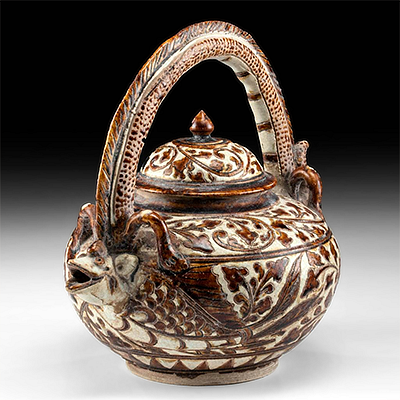Nazca Polychrome Bridge Spout Vessel Frogs, ex-Museum
Lot 98
About Seller
Artemis Fine Arts
686 S Taylor Ave, Ste 106
Louisville, CO 80027
United States
Selling antiquities, ancient and ethnographic art online since 1993, Artemis Gallery specializes in Classical Antiquities (Egyptian, Greek, Roman, Near Eastern), Asian, Pre-Columbian, African / Tribal / Oceanographic art. Our extensive inventory includes pottery, stone, metal, wood, glass and textil...Read more
Categories
Estimate:
$1,500 - $2,250
Absentee vs Live bid
Two ways to bid:
- Leave a max absentee bid and the platform will bid on your behalf up to your maximum bid during the live auction.
- Bid live during the auction and your bids will be submitted real-time to the auctioneer.
Bid Increments
| Price | Bid Increment |
|---|---|
| $0 | $25 |
| $300 | $50 |
| $1,000 | $100 |
| $2,000 | $250 |
| $5,000 | $500 |
| $10,000 | $1,000 |
| $20,000 | $2,500 |
| $50,000 | $5,000 |
| $100,000 | $10,000 |
| $200,000 | $20,000 |
About Auction
By Artemis Fine Arts
Jul 1, 2021
Set Reminder
2021-07-01 10:00:00
2021-07-01 10:00:00
America/New_York
Bidsquare
Bidsquare : Antiquities | Asian | Ethnographic Art
https://www.bidsquare.com/auctions/artemis-gallery/antiquities-asian-ethnographic-art-7148
Featuring classical antiquities, ancient and ethnographic art from cultures encompassing the globe. Egyptian, Greek, Roman, Near Eastern, Asian, Pre-Columbian, Native American, African / Tribal, Oceanic, Spanish Colonial, Russian, Fossils, Fine Art, more! All legally acquired, legal to sell. Artemis Fine Arts info@artemisfinearts.com
Featuring classical antiquities, ancient and ethnographic art from cultures encompassing the globe. Egyptian, Greek, Roman, Near Eastern, Asian, Pre-Columbian, Native American, African / Tribal, Oceanic, Spanish Colonial, Russian, Fossils, Fine Art, more! All legally acquired, legal to sell. Artemis Fine Arts info@artemisfinearts.com
- Lot Description
Pre-Columbian, South Coast Peru, Nazca, ca. 2nd to 4th century CE. An exquisitely painted bridge-spout vessel of a globular form with a rounded base and a mesmerizing arrangement of frogs across its exterior. At its top is a pair of spouts connected by a thin bridge, painted all over in a deep burgundy red hue. The vessel's body has a russet red ground and boasts its most prominent feature - a series of whimsically painted frogs with dark bodies accented with interchanging streaks of cream, orange, blue, and purple hues. Each frog has an identical look of splendor splashed across its face. What a ray of sunshine! Size: 6" W x 6.75" H (15.2 cm x 17.1 cm)
Toads and frogs are common iconography in the pre-Columbian New World, where their tadpole-to-land-animal life cycle resulted in them becoming symbols of rebirth. Some toads were also known for their hallucinogenic secretions and toad remains are commonly found in tombs. The Jesuit Bernabe Cobo, in his "Historia del Nuevo Mundo" written in the early 1600s, recorded that the common toad (in Quechua, the "hampatu") was venerated by local people in the Andes. He noted its connection to water, and Incan art (a successor of the Nazca), such as the stone of Sayhuite, depicts toads in water basins and near other symbols of water. From the life-giving properties of water, it seems likely that toads were also associated with fertility.
Provenance: ex-Ashland University Museum, Ashland, Ohio, USA
All items legal to buy/sell under U.S. Statute covering cultural patrimony Code 2600, CHAPTER 14, and are guaranteed to be as described or your money back.
A Certificate of Authenticity will accompany all winning bids.
We ship worldwide and handle all shipping in-house for your convenience.
#165423Surface wear commensurate with age. Light fading the burnished surface along the bridge. Otherwise, in excellent condition and extremely well conserved. Fully intact and in exemplary form!Condition
- Shipping Info
-
All shipping is handled in-house for your convenience. Your invoice from Artemis Gallery will include shipping calculation instructions. If in doubt, please inquire BEFORE bidding for estimated shipping costs for individual items.
-
- Buyer's Premium



 EUR
EUR CAD
CAD AUD
AUD GBP
GBP MXN
MXN HKD
HKD CNY
CNY MYR
MYR SEK
SEK SGD
SGD CHF
CHF THB
THB














